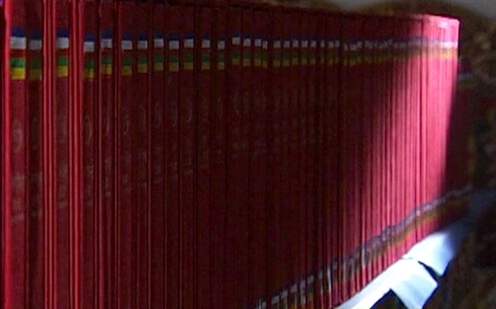Sree Padma. ‘Hariti: Village Origins, Buddhist Elaborations and Saivite Accommodations’. Asian and African Area Studies (『アジア・アフリカ地域研究』), 11 (1), 2011, pp.1–17. [PDF]
International Conference on Tibetan History &c. (2013-7-13)
四川大学中国藏学研究所(会议主办)、哈佛燕京学社(会议协办): “7至17世纪西藏历史与考古、宗教与艺术国际学术研讨会”。 中国·成都·四川大学 2013年7月13-15日。
Center for Tibetan Studies of Sichuan University & Harvard-Yenching Institute (co-conveners). ‘International Conference On Tibetan History And Archaeology, Religion And Art (7th–17th c.)’. Sichuan University, Chengdu, China, July 13–15, 2013. [official site / 2nd circular w/ abstracts]
会议召集 人:霍 巍 教授(四川大学)、范德康 教授(哈佛大学)
Conference conveners: Prof. Huo Wei (Sichuan University) & Prof. Leonard W.J. van der Kuijp (Harvard University).

Continue reading “International Conference on Tibetan History &c. (2013-7-13)”
Emms, Two Mūlasarvāstivādin Vinaya Traditions (2012)
Christopher D. Emms. Evidence for Two Mūlasarvāstivādin Vinaya Traditions in the Gilgit Prātimokṣa-sūtras. M.A. thesis, McMaster University, 2012. 127 pp. Open Access Dissertations and Theses, Paper 7337. [URI/PDF]
From the abstract
The Sanskrit prātimokṣa-sūtras contained in the Gilgit Buddhist manuscripts have been identified as belonging to the Mūlasarvāstivāda school. However, the identification of these manuscripts as Mūlasarvāstivādin texts is problematic. A key factor for determining the school affiliation of a prātimokṣa is the rule order. The Gilgit prātimokṣa-sūtras, however, differ in their rule order. In this thesis, I explore the relationship of these Gilgit prātimokṣa-sūtras to Mūlasarvāstivādin literature. […] I argue that we have evidence for two distinct Mūlasarvāstivādin Vinaya traditions within the Gilgit prātimokṣa-sūtras.
Facsimile Edition of All Palmleaf MSS in the TAR (2012?)
བོད་རང་སྐྱོང་ལྗོངས་སུ་ཉར་ཚགས་བྱས་པའི་ཏ་ལའི་ལོ་མའི་དཔེ་ཆ་ཀུན་བཏུས་པར་མ།
《西藏自治区珍藏贝叶经影印大全》(共61分册)
*Facsimile Edition of Palmleaf Manuscripts in the Tibet Autonomous Region: Complete Collection. 2012(?). 61 vols.བོད་རང་སྐྱོང་ལྗོངས་སུ་ཉར་ཚགས་བྱས་པའི་ཏ་ལའི་ལོ་མའི་དཔེ་ཆ་ཀུན་བཏུས་ཀྱི་དཀར་ཆག་བསྡུས་པ།
《西藏自治区珍藏贝叶经影印大全简目》
*Facsimile Edition of Palmleaf Manuscripts in the Tibet Autonomous Region: Complete Collection. Brief Index. 2012(?).བོད་རང་སྐྱོང་ལྗོངས་སུ་ཉར་ཚགས་བྱས་པའི་ཏ་ལའི་ལོ་མའི་དཔེ་ཆ་བྲིས་མའི་རྩ་བའི་དཀར་ཆག།
《西藏自治区珍藏贝叶经总目录》(共4册)
*Master Catalogue of Palmleaf Manuscripts in the Tibet Autonomous Region. 2012(?). 4 vols.

Continue reading “Facsimile Edition of All Palmleaf MSS in the TAR (2012?)”
Karashima et al, ‘Abhisamācārikā Dharmāḥ’ (2012) [Or: Inappropriate Monastic Wedding Speeches]
What the śrāvakas aren’t supposed to sing to the bride on the happy day:
nagnā nadī anodikā nagnaṃ rāṣṭram arājakam |
istrī 'pi vidhavā nagnā sacesyā daśa bhrātaraḥ || [sic]
This and other abhivinaya jocularity to be found in:
Seishi KARASHIMA unter Mitwirkung von Oskar von Hinüber. Die Abhisamācārikā Dharmāḥ Verhaltensregeln für buddhistische Mönche der Mahāsāṃghika-Lokottaravādins
herausgegeben, mit der chinesischen Parallelversion verglichen, übersetzt und kommentiert. Bibliotheca Philologica et Philosophica Buddhica Volume XIII.1, 2, 3 (Grammatik und Glossar). Tokyo: International Research Institute for Advanced Buddhology, Soka University, 2012. ISBN 978-4-904234-05-1 [PDF flyer fixed]
Clarke, ‘Pārājika: the Myth of Permanent and Irrevocable Expulsion’ (1999)
One of the few scholars currently focusing on vinaya literature is Shayne Clarke. His Masters’ thesis is now available online:
Clarke, Shayne. Pārājika: the Myth of Permanent and Irrevocable Expulsion from the Buddhist Order: A Survey of the Śikṣādattaka in Early Monastic Buddhism. M.A. diss., University of Canterbury, 1999. (URI & abstract / PDF.)
Dr. Clarke and myself had the pleasure of meeting at the 2007 Hamburg Conference on the Ordination of Women, where his learned presentation stood out. (Incidentally, my report of this event became controversial enough to warrant a face-to-face meeting with one of the organizers; they have since put their own views into print. Update: Readers may also wish to consult the conference papers directly. [I trust that the participants gave their consent for online publication.])
If I may say so, Clarke’s thesis reads as an unusually accomplished piece of work for an M.A. (even in its slightly expurgated online form). His understanding of the vinaya as formulated in India is based, as it ought to be, on a survey of multiple nikāyas. In subsequent publications — see this list at his official site — Dr. Clarke effortlessly bins the received view of the Pali canon as the definitive record of the lives of Indian Buddhists.
Finnegan, ‘For the sake of women, too’ (2009)
Finnegan, Damchö Diana. “For the sake of women, too”: Ethics and Gender in the narratives of the Mūlasarvāstivāda Vinaya. PhD diss., University of Wisconsin-Madison, 2009. (PDF.)

